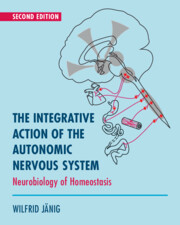Book contents
- The Integrative Action of the Autonomic Nervous System
- Reviews
- The Integrative Action of the Autonomic Nervous System
- Copyright page
- Dedication
- Contents
- Foreword to the Second Edition
- Foreword to the First Edition
- Preface
- Abbreviations
- Introduction The Autonomic Nervous System and the Regulation of Body Functions
- Part I The Autonomic Nervous System: Functional Anatomy and Interoceptive Afferents
- Chapter 1 Functional Anatomy of the Peripheral Sympathetic and Parasympathetic Systems
- Chapter 2 Interoceptive Afferent Neurons and Autonomic Regulation with Special Emphasis on the Viscera
- Part II Functional Organization of the Peripheral Autonomic Nervous System
- Part III Transmission of Signals in the Peripheral Autonomic Nervous System
- Part IV Representation of the Autonomic Nervous System in the Spinal Cord and Lower Brain Stem
- Part V The Centers of Homeostasis in the Mesencephalon and Hypothalamus and Their Telencephalic Control
- Index
- References
Chapter 2 - Interoceptive Afferent Neurons and Autonomic Regulation with Special Emphasis on the Viscera
from Part I - The Autonomic Nervous System: Functional Anatomy and Interoceptive Afferents
Published online by Cambridge University Press: 16 July 2022
- The Integrative Action of the Autonomic Nervous System
- Reviews
- The Integrative Action of the Autonomic Nervous System
- Copyright page
- Dedication
- Contents
- Foreword to the Second Edition
- Foreword to the First Edition
- Preface
- Abbreviations
- Introduction The Autonomic Nervous System and the Regulation of Body Functions
- Part I The Autonomic Nervous System: Functional Anatomy and Interoceptive Afferents
- Chapter 1 Functional Anatomy of the Peripheral Sympathetic and Parasympathetic Systems
- Chapter 2 Interoceptive Afferent Neurons and Autonomic Regulation with Special Emphasis on the Viscera
- Part II Functional Organization of the Peripheral Autonomic Nervous System
- Part III Transmission of Signals in the Peripheral Autonomic Nervous System
- Part IV Representation of the Autonomic Nervous System in the Spinal Cord and Lower Brain Stem
- Part V The Centers of Homeostasis in the Mesencephalon and Hypothalamus and Their Telencephalic Control
- Index
- References
Summary
Visceral organs are innervated by vagal and spinal visceral afferent neurons. Of the axons in the vagal nerves, 85% are afferent and have their cell bodies in the nodose or jugular ganglion. Vagal afferents are involved in autonomic reflexes and regulation, and in visceral sensations but not pain. They project viscerotopically to the nucleus tractus solitarii. Spinal visceral afferent neurons have their cell bodies in the dorsal root ganglia. They are involved in organ reflexes, organ regulation (pelvic organs), extraspinal "peripheral" reflexes, protective "axon reflex"-mediated effector reactions, non-painful visceral sensations and visceral pain. Thoracolumbar spinal visceral afferent neurons are polymodal and activated by mechanical and chemical stimuli. Sacral visceral afferent neurons are involved in specific organ regulation, and sacro-lumbar reflexes. Spinal visceral afferents project to lamina I, lamina V and deeper laminae of the spinal gray matter. All spinal neurons receiving synaptic input from spinal visceral afferents are convergent viscero-somatic neurons. In primates, lamina I neurons project topographically to the posterior part of the ventromedial nucleus of the thalamus. This nucleus projects topographically to the dorsal posterior insula, which is the primary interoceptive cortex and represents sensations related to the states of the body tissues.
Keywords
- Type
- Chapter
- Information
- The Integrative Action of the Autonomic Nervous SystemNeurobiology of Homeostasis, pp. 34 - 70Publisher: Cambridge University PressPrint publication year: 2022



